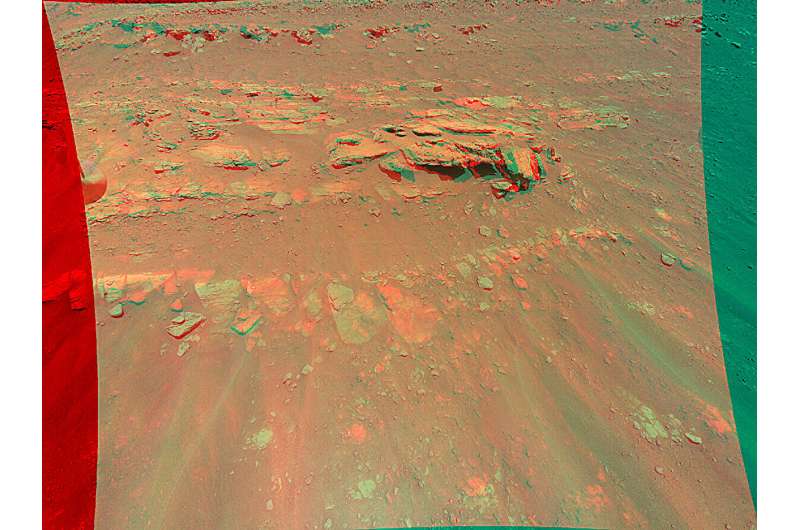"Our next-generation Mars helicopter testing has literally had the best of both worlds," said Teddy Tzanetos, Ingenuity's project manager and manager for the Mars Sample Recovery Helicopters. "Here on Earth, you have all the instrumentation and hands-on immediacy you could hope for while testing new aircraft components. On Mars, you have the real off-world conditions you could never truly re-create here on Earth." That includes a whisper-thin atmosphere and significantly less gravity than on Earth.
The next-generation carbon fiber rotor blades being tested on Earth are almost 4 inches (more than 10 centimeters) longer than Ingenuity's, with greater strength and a different design. NASA thinks these blades could enable bigger, more capable Mars helicopters. The challenge is that as the blade tips approach supersonic speeds, vibration-causing turbulence can quickly get out of hand.
To find a space big enough to create a Martian atmosphere on Earth, engineers looked to JPL's 25-foot wide, 85-foot-tall (8-meter-by-26-meter) space simulator—a place where Surveyor, Voyager, and Cassini got their first taste of space-like environments. For three weeks in September, a team monitored sensors, meters, and cameras as the blades endured run after run at ever-higher speeds and greater pitch angles.
"We spun our blades up to 3,500 rpm, which is 750 revolutions per minute faster than the Ingenuity blades have gone," said Tyler Del Sesto, Sample Recovery Helicopter deputy test conductor at JPL. "These more efficient blades are now more than a hypothetical exercise. They are ready to fly."
At around the same time, and about 100 million miles (161 million kilometers) away, Ingenuity was being commanded to try things the Mars Helicopter team never imagined they would get to do.
Fourth rock flight testing
Ingenuity was originally slated to fly no more than five times. With its first flight entering the mission logbook more than two-and-a-half years ago, the helicopter has exceeded its planned 30-day mission by 32 times and has flown 66 times. Every time Ingenuity goes airborne, it covers new ground, offering a perspective no previous planetary mission could achieve. But lately, Team Ingenuity has been taking their solar-powered rotorcraft out for a spin like never before.
"Over the past nine months, we have doubled our max airspeed and altitude, increased our rate of vertical and horizontal acceleration, and even learned to land slower," said Travis Brown, Ingenuity's chief engineer at JPL. "The envelope expansion provides invaluable data that can be used by mission designers for future Mars helicopters."
Limited by available energy and motor-temperature considerations, Ingenuity flights usually last around two to three minutes. Although the helicopter can cover more ground in a single flight by flying faster, flying too fast can confuse the onboard navigation system. The system uses a camera that recognizes rocks and other surface features as they move through its field of view. If those features whiz by too fast, the system can lose its way.
So, to achieve a higher maximum ground speed, the team sends commands for Ingenuity to fly at higher altitudes (instructions are sent to the helicopter before each flight), which keeps features in view longer. Flight 61 established a new altitude record of 78.7 feet (24 meters) as it checked out Martian wind patterns. With Flight 62, Ingenuity set a speed record of 22.3 mph (10 meters per second)—and scouted a location for the Perseverance rover's science team.
The team has also been experimenting with Ingenuity's landing speed. The helicopter was designed to contact the surface at a relatively brisk 2.2 mph (1 mps) so its onboard sensors could easily confirm touchdown and shut down the rotors before it could bounce back into the air.
A helicopter that lands more slowly could be designed with lighter landing gear. So, on Flights 57, 58, and 59 they gave it a whirl, demonstrating that Ingenuity could land at speeds 25% slower than those at which it was originally designed to land.
All this Martian Chuck Yeager-ing is not over. In December, after solar conjunction, Ingenuity is expected to perform two high-speed flights, during which it will execute a special set of pitch-and-roll angles designed to measure its performance.
"The data will be extremely useful in fine-tuning our aero-mechanical models of how rotorcraft behave on Mars," said Brown. "On Earth, such testing is usually performed in the first few flights. But that's not where we're flying. You have to be a little more careful when you're operating that far away from the nearest repair shop, because you don't get any do-overs."
Provided by NASA



